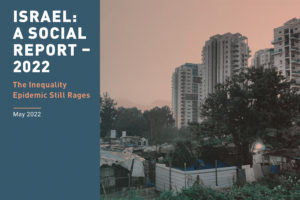The report analyses the extent of the economic, social, military, political and diplomatic burden of the conflict on Israel. Among the report’s highlights: The prolonged conflict with the Palestinians undermines sustainable economic growth, burdens the budget, limits social development, absorbs most of the energies of the political leadership, calls into question the legitimacy of the actions of the Israeli Defense Forces and isolates Israel internationally. The burden … Continue reading The Cost of Occupation – The Burden of the Israeli-Palestinian Conflict: 2010 Report →
|
The report analyses the extent of the economic, social, military, political and diplomatic burden of the conflict on Israel.
Among the report’s highlights:
The prolonged conflict with the Palestinians undermines sustainable economic growth, burdens the budget, limits social development, absorbs most of the energies of the political leadership, calls into question the legitimacy of the actions of the Israeli Defense Forces and isolates Israel internationally.
The burden of the conflict includes:
- Double threat to the Israeli economy instead of one: global crises and crises caused by the conflict. As a result, during the last decade (2000-2008), Israel’s economic growth per capita grew more slowly than that of the countries of East Asia and Eastern Europe, at a rate similar to that of Western countries. The problem is that in order to reach parity with Western countries,
Israel needs to grow at a rate similar to that of the emerging economies of Asia and Eastern Europe.
- Low credit rating, in relative terms: Israelis are proud of their country’s credit rating, but the figures show that Israel is ranked no higher than 40 among the nations. Most of the developed countries have a rating of AAA, while Israel’s rating is A.
- Budgets go for guns, not butter: Between 1989 and 2010, the Ministry of Defense received budget increments earmarked for the Palestinian conflict in the amount of NIS 45.3 billion (2009 prices) – a sum that exceeds the 2009 budgetary outlay for schools and institutes of higher learning.
- Guns or butter is the name of the game: The prolonged conflict forces Israel to choose again and again between guns and butter. The following diagram shows the difference between changes in the per capita defense outlay and the per capita social services outlay, for the last decade. Following cutbacks in the wake of the Intifadah, the per capita social services outlay declined during much of the decade to below its 2000 level. In contrast, for most of the years in question, the per capita defense outlay exceeded the outlay in 2000 (with the exception of 2003 and 2004, when the Intifadah ran its course). It was only in 2008 and 2009 that the per capita social services outlay grew more than the per capita defense outlay.
Changes in Per Capita Outlay for Defense and for Social Services, 2000-2009
Index: 2000=100

|
|




